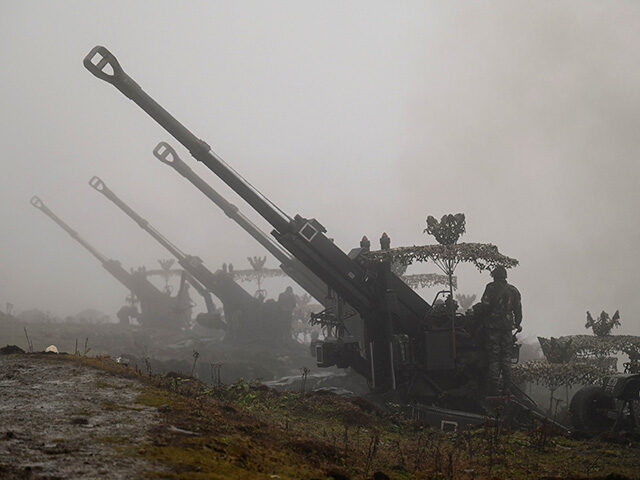The Indian Defense Ministry announced this week that it had begun a joint army exercise alongside Saudi Arabia named “Sada Tanseeq,” or “Forever in Coordination,” expected to run through February 10.
The event is the first of its kind uniting the armies of Saudi Arabia and India.
India is hosting the exercises in the northern state of Rajasthan, which borders Pakistan and hosts a military complex used for desert terrain training. The exercises are small; the Indian Defense Ministry stated that each country is sending 45 service members each from the Royal Saudi Land Forces and Indian Army. While the two nations have engaged in naval exercises in the past, “Sada Tanseeq” represents a significant elevation in defense cooperation and indicate that Riyadh and New Delhi are seeking to dramatically expand their friendship beyond economic and technology cooperation.

Indian Prime Minister Narendra Modi, right, shakes hand with Crown Prince Mohammed bin Salman of Saudi Arabia upon his arrival at Bharat Mandapam convention center for the G20 Summit in New Delhi, India, on September 9, 2023. (AP Photo/Evan Vucci)
Saudi Arabia has traditionally maintained friendlier ties with India’s top geopolitical ally Pakistan, as the two countries are Islamic theocracies governed by the sharia. The dramatic growth of the Indian migrant population of Saudi Arabia, now estimated to number 2.6 million people, has also been a source of tension on occasion, as cases have surfaced of alleged enslavement of Indian nationals and heinous abuse of domestic and labor workers.
Under Crown Prince Mohammed bin Salman, however – the de facto ruler of the country despite the elderly King Salman formally holding the title – the two countries have explored agreements in increasing technology cooperation, joint diplomatic works, and trade deals. The two are now officially allies under the framework of BRICS, a global coalition named after its founding members Brazil, Russia, India, China, and South Africa. Saudi Arabia became one of five states – alongside Iran, the United Arab Emirates (UAE), Egypt, and Ethiopia – to join BRICS in 2024.
The official announcement of Sada Tanseeq described the goal of the operation as giving the countries a chance to “share their best practices in the tactics, techniques and procedures of conducting operations in sub-conventional domain.”
“The Exercise will provide an opportunity to both the contingents to strengthen their bond. It will act as a platform to achieve shared security objectives, enhance the level of defence cooperation and foster bilateral relations between the two friendly nations,” the Indian Defense Ministry added.
Watch video here:
The Indian outlet First Post noted that the Saudi exercises followed a similar event in December in Rajasthan in which Indian troops engaged in drills with counterparts from the UAE, another new BRICS member.
“The presence of Saudi troops in India sends a clear message to the Islamic world that New Delhi has gained the trust of nations in West Asia,” First Post concluded, adding Saudi Arabia had begun a “clear shift” in drifting towards India and away from Pakistan.
The drills appear to be the result of talks between Mohammed bin Salman and Indian Prime Minister Narendra Modi during the former’s visit to New Delhi in September. The crown prince traveled to the country for the G20 summit but stayed for another day of meetings with Indian officials. The two leaders reportedly dedicated much of their discussions to collaborating on oil refining. The Hindustan Times reported at the time that Saudi Arabia was planning a $100-billion investment in India’s prolific oil refining capacity. It added, however, that defense was one of the subjects on the itinerary for the leaders’ meeting.
HRH Crown Prince Mohammed bin Salman and Prime Minister of India @narendramodi sign minutes of the Strategic Partnership Council between the Government of the Kingdom of Saudi Arabia and the Government of the Republic of India. pic.twitter.com/INtpQQGeKj
— Foreign Ministry 🇸 (@KSAmofaEN) September 11, 2023
Earlier in 2023, officials from both countries held meetings to discuss the potential of a collaborative effort to build undersea cables intended to link the Saudi and Indian power grids, according to the region outlet Arab News, which noted that the UAE was also involved in talks with India for a similar infrastructure initiative.
Fostering ties with the UAE and Saudi Arabia could help India elevate its influence in BRICS, where it stands out for its fraught relationship with nominal ally China. India and China have harbored a territorial dispute along their mutual border for years, which finally boiled over into a deadly military engagement in June 2020. The appearance of Chinese People’s Liberation Army (PLA) soldiers on Indian land resulted in a confrontation that reportedly killed about 20 Indian soldiers and at least double the number of PLA troops. China has admitted only to four deaths in the exchange. The battle at the Galwan Valley, in the Himalayan Indian state of Ladakh, was a major international embarrassment for the Chinese military and has continued to prevent India and China from fully embracing their mutual presence in BRICS.
India has also directly challenged China’s supremacy as a manufacturing superpower, launching a program called “Make in India” intended to attract foreign investment into Indian manufacturing. “Make in India” received a major boost from China’s “zero-Covid” policy, which forced factories into interminable, harrowing lockdowns that significantly damaged their productivity. Two of the largest manufacturers in China, Apple and its supplier Foxconn, cut deals with India to grow their presence there in the aftermath of the pandemic.

COMMENTS
Please let us know if you're having issues with commenting.